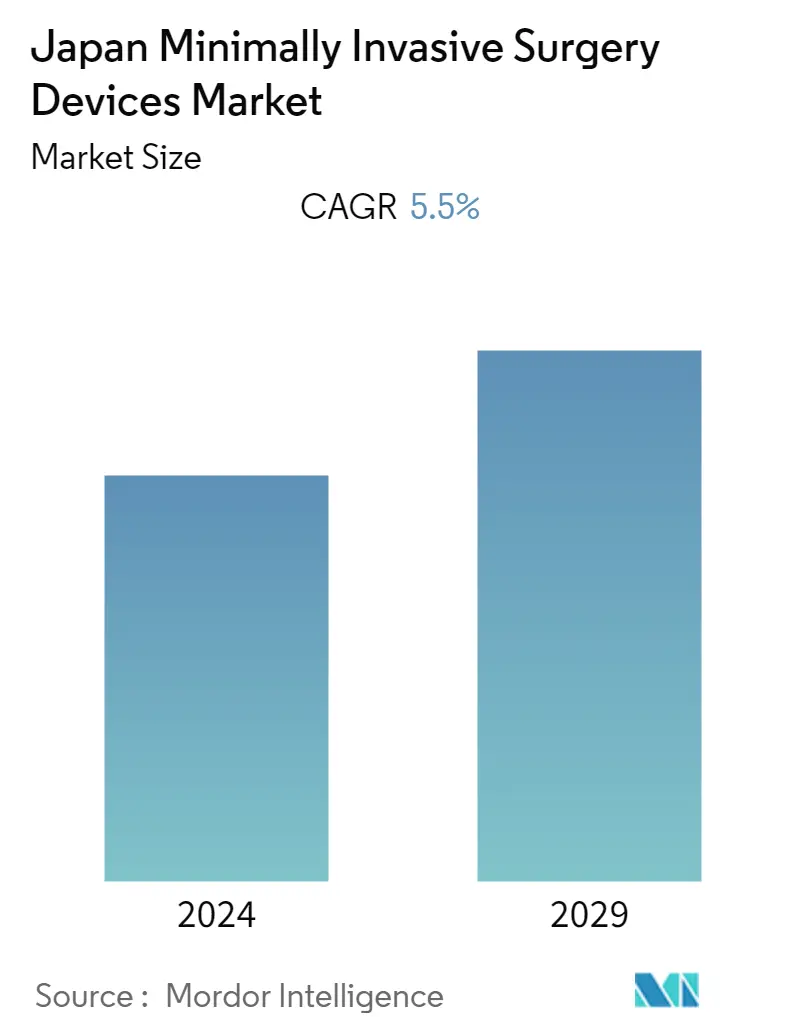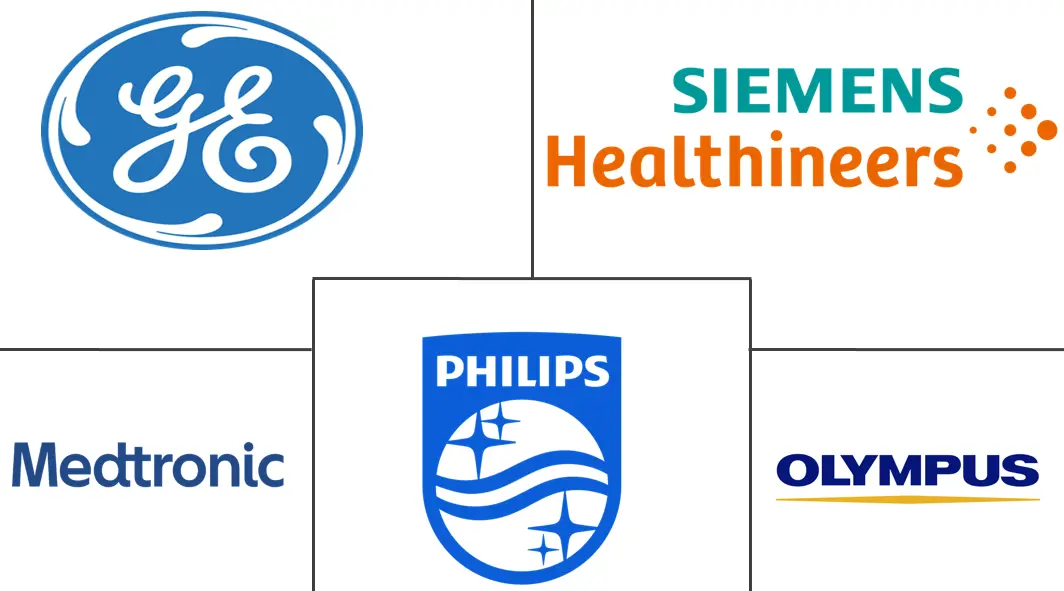Market Size of Japan Minimally Invasive Surgery Devices Industry

| Study Period | 2019 - 2029 |
| Base Year For Estimation | 2023 |
| Forecast Data Period | 2024 - 2029 |
| Historical Data Period | 2019 - 2022 |
| CAGR | 5.50 % |
Major Players
*Disclaimer: Major Players sorted in no particular order |
Japan Minimally Invasive Surgery Devices Market Analysis
The Japanese minimally invasive surgery devices market is expected to register a CAGR of 5.5% over the forecast period.
The COVID-19 pandemic impacted the growth of the market. The lockdown measures and restrictions imposed by the government disrupted the supply chain activities and suspended non-urgent scheduled visits and hospitalizations, which affected the demand for minimally invasive surgical devices during the pandemic. Canceling elective procedures to avoid the spread of COVID-19 and reserving resources for COVID patients has slowed down the market's growth. An article published in the Surgical Today Journal in January 2022 observed that most surgical procedures, such as oncological and cardiovascular procedures, decreased in 2020 in Japan. The overall decline in the surgery rate was 10%-15%. Thus, the decreased surgical procedures have impacted the demand for surgical devices and monitoring devices used for minimally invasive surgeries. However, with the release restrictions and resumed surgical procedures, the market studied is expected to grow over the forecast period.
Certain factors propelling the market's growth are the increasing prevalence of lifestyle-related and chronic disorders, technological advancements, and the rising geriatric population in Japan.
Minimally invasive surgical (MIS) procedures have several advantages over conventional procedures, such as less post-operative pain, fewer major operative and post-operative complications, faster recovery times, less scarring, less stress on the immune system, and smaller incisions. These benefits of minimally invasive procedures reduce the overall hospital and the cost of the treatment, due to which MIS procedures are being preferred, which is expected to drive the market's growth.
The growing prevalence of chronic diseases such as cancer and cardiovascular diseases is driving the demand for surgical procedures for treatment, augmenting the growth of the market studied. For instance, according to the GLOBOCAN 2020 report, Japan reported 1,028,658 new cancer cases (599 243 new cancer cases in males and 429 415 new cancer cases in females) in 2020. The same report projected the number of cancer cases to reach 1,110,549 by 2030 and 1,128,057 by 2040. Thus, the increasing burden of cancer among Japanese people increases the demand for surgical procedures, which is expected to increase the demand for surgical devices, thereby boosting the market's growth.
According to the 2022 statistics published by IDF, 11 million people were living with diabetes in 2021 in Japan. This number is projected to increase by 2030. The high blood sugar caused by diabetes can damage the nerves that control the heart and blood vessels, leading to cardiovascular diseases like coronary artery disease and stroke, narrowing the arteries. This is anticipated to boost the demand for surgical procedures, fueling the demand for minimally invasive surgical devices.
New product launches and approvals due to technological advancements, collaborations, mergers, and acquisitions are the key strategic initiatives undertaken by the industry players, which are expected to drive the market's growth. For instance, in August 2022, Abbott laboratories launched a TactiFlex SE irrigation catheter, a radiofrequency (RF) ablation catheter with a slit tip electrode with contact force technology, in Japan. In March 2022, Japan's PMDA approved Shockwave Medical's Shockwave C² Coronary Intravascular Lithotripsy (IVL) Catheter. In May 2021, Japan Lifeline and Galaxy Medical entered into an exclusive distribution agreement for the ALPHA1 ablation catheter in the United States. Under the terms of the agreement, Galaxy pursues US regulatory approval for ALPHA1 in support of the eventual commercialization of the CENTAURI PEF System.
However, the shortage of experienced professionals is expected to hinder the market's growth over the forecast period.
Japan Minimally Invasive Surgery Devices Industry Segmentation
According to the scope of the report, minimally invasive surgical devices refer to electrosurgical systems, robot-assisted surgical systems, and surgical equipment used during minimally invasive procedures. Minimally invasive surgery refers to any surgical procedure performed through tiny incisions instead of a large opening, leading to quicker recovery, minimal blood loss, and less pain than traditional open surgery.
The Japanese minimally invasive surgery devices market is segmented by products (handheld instruments, guiding devices, electrosurgical devices, endoscopic devices, laparoscopic devices, monitoring and visualization devices, robotic-assisted surgical systems, ablation devices, laser-based devices, and other MIS devices), application (cardiovascular, gastrointestinal, gynecological, orthopedic, urological, and other applications). The report offers the value (in USD million) for all the above segments.
| By Product | |
| Handheld Instruments | |
| Guiding Devices | |
| Electrosurgical Devices | |
| Endoscopic Devices | |
| Laproscopic Devices | |
| Monitoring and Visualization Devices | |
| Robotic Assisted Surgical Systems | |
| Ablation Devices | |
| Laser Based Devices | |
| Other MIS Devices |
| By Application | |
| Cardiovascular | |
| Gastrointestinal | |
| Gynecological | |
| Orthopedic | |
| Urological | |
| Other Applications |
Japan Minimally Invasive Surgery Devices Market Size Summary
The Japanese minimally invasive surgery devices market is poised for growth, driven by factors such as the increasing prevalence of chronic diseases, technological advancements, and a rising geriatric population. Despite the initial setbacks caused by the COVID-19 pandemic, which disrupted supply chains and led to a decline in elective surgeries, the market is expected to recover and expand. Minimally invasive surgical procedures offer numerous advantages over traditional methods, including reduced postoperative pain, fewer complications, and faster recovery times, making them a preferred choice for both patients and healthcare providers. The growing demand for surgical procedures, particularly for cancer and cardiovascular diseases, is further propelling the market's expansion.
The market is characterized by significant activity in product development and strategic collaborations among key players. Companies are focusing on launching new products and obtaining regulatory approvals to enhance their market presence. The gastrointestinal segment is anticipated to witness substantial growth due to the high incidence of related diseases, while the robotic-assisted surgical systems segment is expected to expand due to the increasing adoption of advanced surgical technologies. The market's consolidation is evident with major players like GE Healthcare, Koninklijke Philips NV, Medtronic PLC, and Olympus Corporation actively engaging in mergers, acquisitions, and product innovations to maintain their competitive edge.
Japan Minimally Invasive Surgery Devices Market Size - Table of Contents
-
1. MARKET DYNAMICS
-
1.1 Market Overview
-
1.2 Market Drivers
-
1.2.1 Increasing Prevalence of Lifestyle-related and Chronic Disorders
-
1.2.2 Technological Advancements
-
-
1.3 Market Restraints
-
1.3.1 Shortage of Experienced Professionals
-
-
1.4 Porter's Five Force Analysis
-
1.4.1 Threat of New Entrants
-
1.4.2 Bargaining Power of Buyers/Consumers
-
1.4.3 Bargaining Power of Suppliers
-
1.4.4 Threat of Substitute Products
-
1.4.5 Intensity of Competitive Rivalry
-
-
-
2. MARKET SEGMENTATION (Market Size by Value - USD million)
-
2.1 By Product
-
2.1.1 Handheld Instruments
-
2.1.2 Guiding Devices
-
2.1.3 Electrosurgical Devices
-
2.1.4 Endoscopic Devices
-
2.1.5 Laproscopic Devices
-
2.1.6 Monitoring and Visualization Devices
-
2.1.7 Robotic Assisted Surgical Systems
-
2.1.8 Ablation Devices
-
2.1.9 Laser Based Devices
-
2.1.10 Other MIS Devices
-
-
2.2 By Application
-
2.2.1 Cardiovascular
-
2.2.2 Gastrointestinal
-
2.2.3 Gynecological
-
2.2.4 Orthopedic
-
2.2.5 Urological
-
2.2.6 Other Applications
-
-
Japan Minimally Invasive Surgery Devices Market Size FAQs
What is the current Japan Minimally Invasive Surgery Devices Market size?
The Japan Minimally Invasive Surgery Devices Market is projected to register a CAGR of 5.5% during the forecast period (2024-2029)
Who are the key players in Japan Minimally Invasive Surgery Devices Market?
Medtronic PLC, Olympus Corporation, Siemens Healthineers, Koninklijke Philips NV and GE Healthcare are the major companies operating in the Japan Minimally Invasive Surgery Devices Market.

